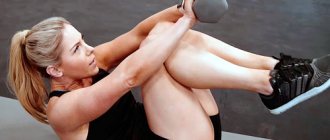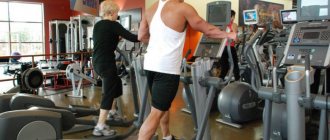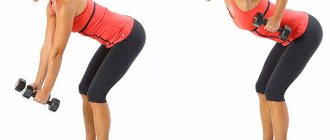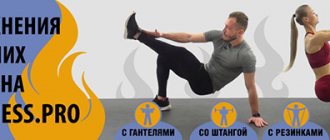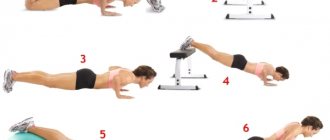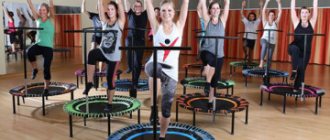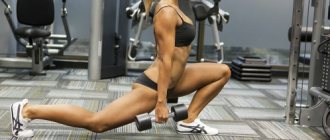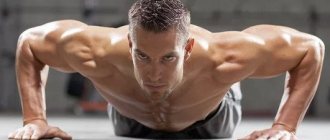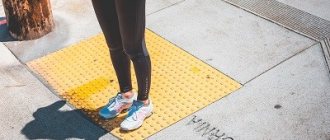Benefits of Exercise
Reverse hyperextension is considered safer compared to the classic version - the risks of spinal injuries are practically eliminated. Such training is recommended for back pain or problems with the spine. This exercise is suitable if you have a hernia, protrusion or osteochondrosis of the intervertebral discs.
In addition to the back, the muscles of the legs and buttocks are well used here. Thanks to this, you can use more weight and, as a result, get results faster.
Important! In the gym, always consult with a trainer about the advisability of performing certain exercises. If you have problems with your spine, be sure to tell your trainer and consult your doctor.
Ways to do the workout
The exercise can be performed in different ways. The main methods are:
- You need to lie on a surface such as a sofa, chair, bed, face down. The main thing is that the hips are on the edge and the torso can bend down freely. The assistant must securely fix the feet. Next, you need to straighten your back so that your legs and torso are on the same straight line. Clasp your hands behind your head. After this, bend smoothly and slowly so that the angle between the upper and lower parts of the body is approximately 60°, then return to the starting position. You need to perform this exercise 2-3 approaches 10-15 times.
- This exercise is done on the floor. Lie face down on the mat. Extend your arms forward in front of you, then simultaneously lift your torso and legs without lifting your hips off the floor. Stay at the top for a few seconds and slowly return to the starting position. It is important not to throw your head back, since the neck is an extension of the back. Repeat the exercise up to 3 sets of 15-20 times.
- You will need a fitball (gymnastic ball). To begin, you need to lie on your stomach on the ball and clasp your hands behind your head. In the first lessons, to maintain balance, you can use a wall, resting your feet on it. As you inhale, lift your body as high as possible and try to stay in this position for 2-3 seconds. As you exhale, return to the starting position. Be careful as the fitball is extremely unstable. Perform the exercise 2-3 sets of 15 times.
- Reverse hyperextension. The exercise is performed on the floor and differs from the second option in that only the legs come off the floor. First, lie on your stomach and straighten your legs. Inhale and slowly raise your legs. Stay in this position for a couple of seconds, then smoothly lower your legs to the floor. To make it more convenient, you can hold onto a chair or some other object with your hands, but in this case the exercise will be less effective. This version of the exercise must be repeated 3 sets of 20 times.
Working muscles
With reverse hyperextension, mainly the muscles of the posterior surface of the body develop, in particular:
- gluteus maximus muscles;
- back extensors;
- hamstring biceps;
- quadratus lumborum muscles;
- semitendinosus muscles.
In addition, the abdominal muscles perform the function of stabilizing the torso, and the arms work statically.
Work of muscles and joints
The main working muscle groups, of course, are the target muscles, namely the gluteus maximus and biceps femoris, and the long back muscle also receives a load, but its role is optional. The remaining muscle groups simply serve as stabilizers, so the load they receive is not significant. There is no need to try to load the gluteus medius muscle as well, since for this you will also have to move your legs to the sides, which will create excessive stress on the joints. In order to place more emphasis on the load on the hamstrings, the socks can be turned inward, which will allow you to better concentrate on working the muscles.
When performing reverse hyperextension, only one joint works, which, nevertheless, is large and strong, therefore, despite the fact that the exercise is formative, the athlete can afford to use fairly large working weights. The working joint, of course, is the hip, so in order for it to be filled with synovial fluid, you need to warm up thoroughly at the beginning of In addition, the body remains in a fixed position throughout the entire range of movement, so you don’t have to worry about the spine, although, of course, if you really want to, then anything is possible.
Execution technique
Before performing the exercise, you need to choose a surface on which you can lie on your stomach and lower your legs down. The height of the surface should be approximately equal to the length of your legs.
Reverse hyperextension involves the following technique:
- Secure the body with your hands.
- Raise your legs slightly, tensing your buttocks and thighs. Do not relax them from the beginning to the end of the approach.
- Raise your legs as you exhale as high as the stretch allows. Concentrate on your buttocks and thighs.
- Hold your legs in the upper position for a second, and while inhaling, lower them down to the starting position.
- Repeat 12 to 15 times. Do 2-3 sets with rest breaks.
Reverse hyperextension - diagram
1) The exercise can be performed in a specialized simulator, can be performed in a simulator for regular hyperextension, or simply on a board fixed at chest level. 2) Wherever you perform the exercise, the supporting point of the body will be the upper and middle part of the abs up to the navel; you should hold the body in a fixed position with your hands. 3) In the starting position, the hamstrings and gluteal muscles should be slightly tense, so the legs should be raised just a little. 4) Using the force of the hamstrings and buttocks, as if curling them, raise your legs above your lower back to the point of peak contraction of the gluteal muscles and hamstrings. 5) Holding the body position for a second at the point of peak muscle contraction, lower them under control to the starting position.
Reverse Hyperextension - Notes
1) An additional load is tied with a rope to the legs, and weights or dumbbells are clamped with the feet, while climbing onto the machine with the load already attached. 2) Try to perform the exercise within the amplitude, stretching the muscles as much as possible, but without relaxing them, so that they remain under load all the time. 3) Be sure to roll the toe inward as much as possible to load more of the hamstrings. 4) Do not swing or try to perform a repetition due to inertia; it is better to do a partial repetition correctly than a full repetition and risk injury. 5) Do not forget about breathing, despite the fact that the position of the body will constrain it, remember, inhale in the negative phase and exhale powerfully with effort.
Anatomy
The legs are the largest muscle group in the human body, so they need to be given proper attention, working all the muscles separately. Men, of course, pay more attention to their quadriceps and hamstrings, while girls purposefully pump up their buttocks. Reverse hyperextension will allow you to pump up both the hamstrings and the gluteal muscles, since both perform similar functions. The biceps femoris is located at the back of the leg and consists of two heads, both of which are pumped in this exercise. The buttocks are located under the lower back and consist of three heads: large, medium and small. The gluteus maximus muscle is the strongest, therefore, whenever it is able to take on a load, it takes it, and therefore neither the gluteus medius nor the gluteus minimus muscles will receive the load.
To summarize, we can say that reverse hyperextension is a very effective formative exercise that allows you to specifically work the back of the leg and buttocks. The exercise is recommended for athletes of any level of training and gender, but each athlete has its own nuances. Beginners should perform the exercise without additional weights, while experienced athletes are recommended to use additional loads in order to increase strength and build muscle mass. Girls should perform this hyperextension variation with moderate weights so that they can mentally tune into working their glutes, which will greatly increase the benefits of their workout.
Bodybuilding Exercises
Execution Variations
There is a special simulator for this exercise, but it is not very common in modern gyms. Therefore, the question often arises about what can replace the reverse hyperextension machine. In fact, this exercise can be performed on any surface that allows you to achieve the desired body position.
There are such variations:
- on fitball;
- on a bench at an angle of 45°;
- with leg bending.
Reverse hyperextension technique: 6 options
There are many different variations for this exercise. They allow you to perform reverse hyperextension at home and in the gym with equal effectiveness. Choose the option that best suits your goals.
Reverse hyperextension in the simulator
The classic version is aimed at training the lower back. Although the glutes and hamstrings are also included in the work, they are not the dominant groups.
Technique:
- Lie your body on the machine and grab the handles (or any other support) with your hands. The legs should be down in the starting position.
- Begin to raise your closed legs together so that they rise slightly above parallel to the floor.
- Without pausing, return your legs down and repeat the movement.
Exhale when lifting your legs up, inhale when lowering them. It is extremely important that the pads of the exercise machine are located in the lower abdomen. This allows you to perform the exercise correctly and correctly fixes the body.
Reverse hyperextension on a bench
Typically, reverse hyperextension on a bench is performed in cases where the gym does not have the necessary equipment. The exercise has the same features and technique as the usual version in the simulator, differing only in a shortened range of motion.
Technique:
- Lie down on the bench so that its edge is in the lower abdomen (just above the groin area). Hug her tightly, fixing your hands on the bottom of the bench. Legs are brought together.
- Begin to lift your legs up, bringing them slightly above parallel to the floor.
- At the top point, take a minimal pause, then return to the starting position.
It is important not to lower your feet to the floor so that the tension is maintained throughout the entire approach. Otherwise, the exercise will significantly lose its effectiveness (this option is used only during rehabilitation, to strengthen the lower back and minimize long-term tension in the problem area).
Reverse hyperextension in Smith (bar leg push)
This is a version of the reverse glute hyperextension. Using it to train the lower back is ineffective, since the load is redistributed to the gluteal region. It is considered the most powerful version of the exercise due to the use of large weights.
Technique for performing reverse hyperextension in Smith:
- Lie down on the bench and grab it tightly with your arms. Bend your knees at a right angle and place your foot on the barbell.
- Start pushing the bar up as high as possible.
- Pause at the bottom, then lower your legs to the starting position.
It is important to remember that the excessive hyperextension in the lower back that occurs in this movement can negatively affect the health of the spine. Therefore, this version should be approached gradually, with a sufficiently trained lower back and after a thorough warm-up. Also, this movement cannot be performed without a partner (his role is reduced to belaying, removing and installing the bar on the safeties).
Reverse hyperextension in the lower block of the crossover
Another option that is more designed for pumping the buttocks . For it to be effective, it is important to understand which muscles work in reverse hyperextension in a standing position. With this technique, the back takes minimal part, the main load falls on the buttocks and hamstrings. Therefore, it is important to perform this movement on leg day, not back day.
Technique:
- Set the appropriate weight in the block.
- Attach the cuffs to your ankles and lie on your stomach on the bench upside down at a 45-degree angle.
- Begin lifting your legs as you would in a normal reverse hyperextension.
- Pause briefly and return your legs to the starting position.
In one set, you need to perform a series of 10-12 repetitions for each leg.
Option for reverse hyperextension at home
For this option, any table, sofa or other surface that will allow you to securely fix the case is suitable. This option is as close as possible to the bench technique due to the shortened amplitude.
Technique:
- Fix the body on the surface and hold onto any support with your hands. Place your feet on the floor and bring them together (with minimal bending at the knees).
- Start raising your legs at a moderate pace as high as possible.
- Without pausing, lower your legs to the starting position and repeat the movement.
It is important to keep your feet on the floor to maintain tension in the target area.
Reverse hyperextension on a fitball
The reverse hyperextension option on a fitball is one of the most health-improving. Due to unstable support, additional muscles are involved in the work. There is also a version in which the fitball is clamped with the feet, but it is significantly less effective (due to the strong separation of the legs).
Technique:
- Lie on your stomach on the fitball. Place your hands on the floor or grab any support. Legs are brought together.
- Start raising your legs, bringing them as high as possible.
- Without pausing, return to the starting position and repeat the movement.
Reverse hyperextension at home
Reverse hyperextension refers to workouts that can be done at home. The technique in this case is slightly different, because... difficult to find a suitable surface. To perform it, you need to lie on the floor, cross your arms behind your back or stretch them along your hips.
Did you know? Reverse hyperextension on the floor is the most gentle workout for the back in the presence of a hernia.
Then you need to raise your legs as high as possible, trying to lift the surface of your thigh off the floor. If it is difficult to hold your arms behind your back, stretch them out in front of you and lift them up at the same time as your legs. You can also perform reverse hyperextension on a fitball at home:
- Lie on your stomach on the ball.
- Place your hands on the floor and maintain your balance.
- Raise and lower your legs as in the classic version.
Techniques for performing hyperextension
All classic hyperextension exercises are for the back, and only the reverse one involves the gluteal region to a greater extent. In addition to special exercise machines, classes can be carried out on a bench, on a ball, or lying on the floor.
Hyperextension trainer torneo g 104 – light and compact, convenient for home training
On a special bench
Horizontal hyperextension is performed on the bench, the technique is the same as on the simulator. The legs of the bench are attached to the floor for stability. An assistant should hold your legs. We lie on our stomachs on the bench and slide onto the end edge until we reach our hips so that our torso hangs completely down.
Good to know: The higher the bench, the greater the range of motion, the more effective the training.
The body is strictly horizontal, the back is straight, hands behind the head or crossed in front of you. Slowly, while inhaling, bend down until you feel strong tension in the hips. As you exhale, we slowly rise up. The main condition is that the back must be straight, it cannot be arched or rounded, and swaying of the body is prohibited.
Hyperextension, photo of the correct body position during exercises
On the floor
Hyperextension on the floor is often performed at home, without special equipment. We lie on our stomachs, stretch our arms forward, and keep our back straight. As you inhale, we try to slowly lift your legs off the floor, as high as possible, and as you exhale, we take the starting position.
Then we fix the legs; an assistant can hold your ear or put your feet under the sofa. We clasp our hands behind our heads, inhale and at this time begin to lift our torso up, exhale and lower ourselves down.
The photo shows how to do hyperextension at home
On fitball
Exercises on the ball do not allow you to use significant weight in the workout. Hyperextension on a fitball is complicated by the fact that coordination of movements is required.
We lie face down, the ball in the stomach, arms behind our heads or crossed in front of us, keeping our legs straight, resting our toes on the floor. As we inhale, we strain the muscles of the lumbar region, straighten our back to the limit so that our legs and spine form one straight line. As you exhale, twist downwards.
Hyperextension, technique of performing on a fitball
Reverse hyperextension
Reverse hyperextension helps to work the hamstrings and gluteal muscles, and optionally distributes the load to the long dorsal muscles. This exercise helps stretch the spinal column. Essentially, reverse hyperextension involves the same areas as the classic version of the exercise, but the emphasis is slightly shifted. It is believed that this training option is safer for the spine.
It is convenient to do the reverse exercise on a folding, weight-block aliv sport al 018
The exercise is performed on a simulator or on a special board, which is fixed exactly at the level of the abdomen. The reference point is the middle and upper abdominal area, up to the navel. We lie with our chests on the board, hold on tightly with our hands, raise our legs up, ideally above the lower back, in order to maximally load the muscles. We hold the position for a couple of seconds and slowly lower our legs down. To make the exercise more difficult, you can tie dumbbells or a weight plate to your legs.
Hyperextension for the buttocks, one way to perform the reverse exercise
Important: Working with weights is only recommended for already trained people in good physical shape.
Contraindications
Although reverse hyperextension is classified as a therapeutic exercise and is indicated for various diseases of the spine, such as osteochondrosis, scoliosis, hernias, there are the following contraindications :
- acute diseases of the spine;
- lumbosacral injuries.
Did you know? Fitball was invented in the 50s of the twentieth century as a device for rehabilitation gymnastics for patients with cerebral palsy. Its effect was so great that it was recommended for rehabilitation after various injuries.
How to avoid getting injured
Although this type of training is one of the safest, there are several safety rules when performing it. First, always check the stability of the bench or other surface you choose to rest on. Secondly, make sure that your back always remains straight. Frequently performing reverse hyperextensions with a rounded back can lead to poor posture.
Important! Make sure you breathe correctly: inhale when moving your legs down, exhale when lifting. Holding your breath is prohibited!
Common Mistakes
- Don't do reverse hyperextensions by jerking, as this can hurt your back.
- Before using weights, we recommend that you carefully practice the technique without weights.
- Do not bend your legs - the effectiveness of the exercise decreases sharply
Reverse hyperextension
This exercise does not place stress on the knee joints and is easier to perform than the usual version.
| Lie face down on an elevated horizontal bench with your legs hanging down. Keep your legs slightly bent at the knees, your gaze directed in front of you. Firmly grasp the bench or handles of the exercise machine and look straight ahead. |
| Smoothly raise your legs to body level and hold this position for a second. |
| Lower your legs and take the starting position. |
Recommendations
- To increase the complexity and effectiveness of the exercise, you can perform the workout by holding a fitball between your legs.
- During the exercise, all movements should be smooth. Sudden jerks are not permissible and can injure muscles.
- You should not raise your legs above a horizontal position, as this can lead to injury.
- Reverse hyperextensions can be performed at home by using a table and having a partner sit on it.
Breath
Inhale as you lower your legs and exhale as you rise.
Number of repetitions
The exercise is performed in 4 sets of 10-15 times.
